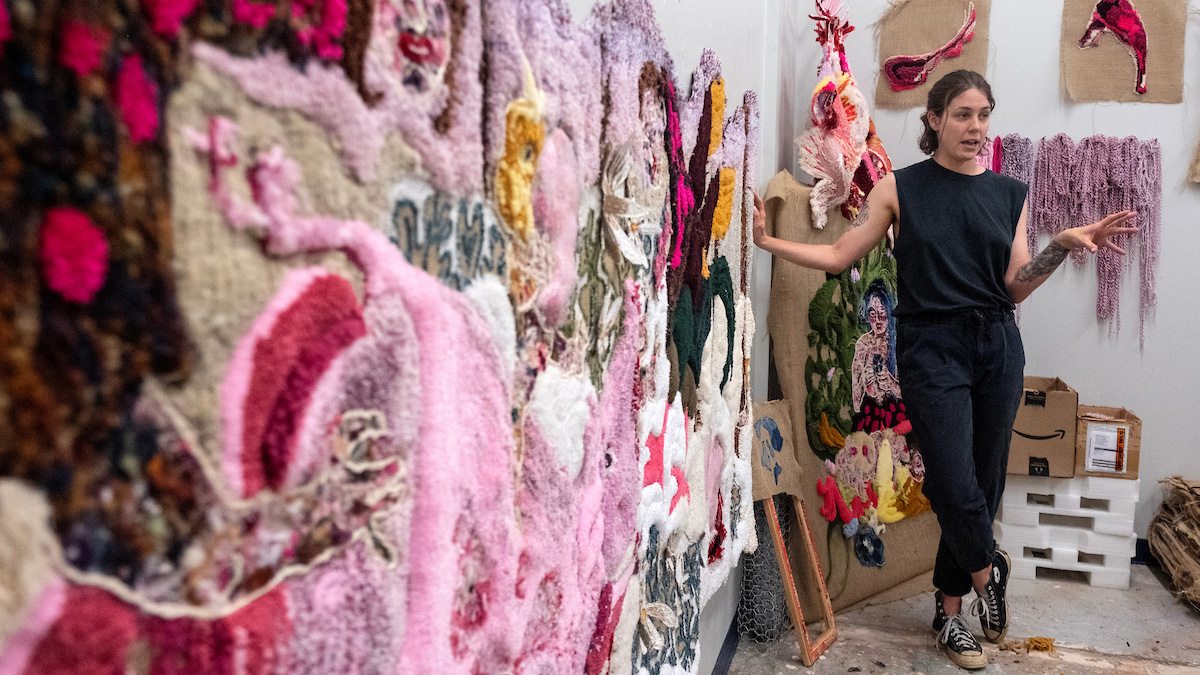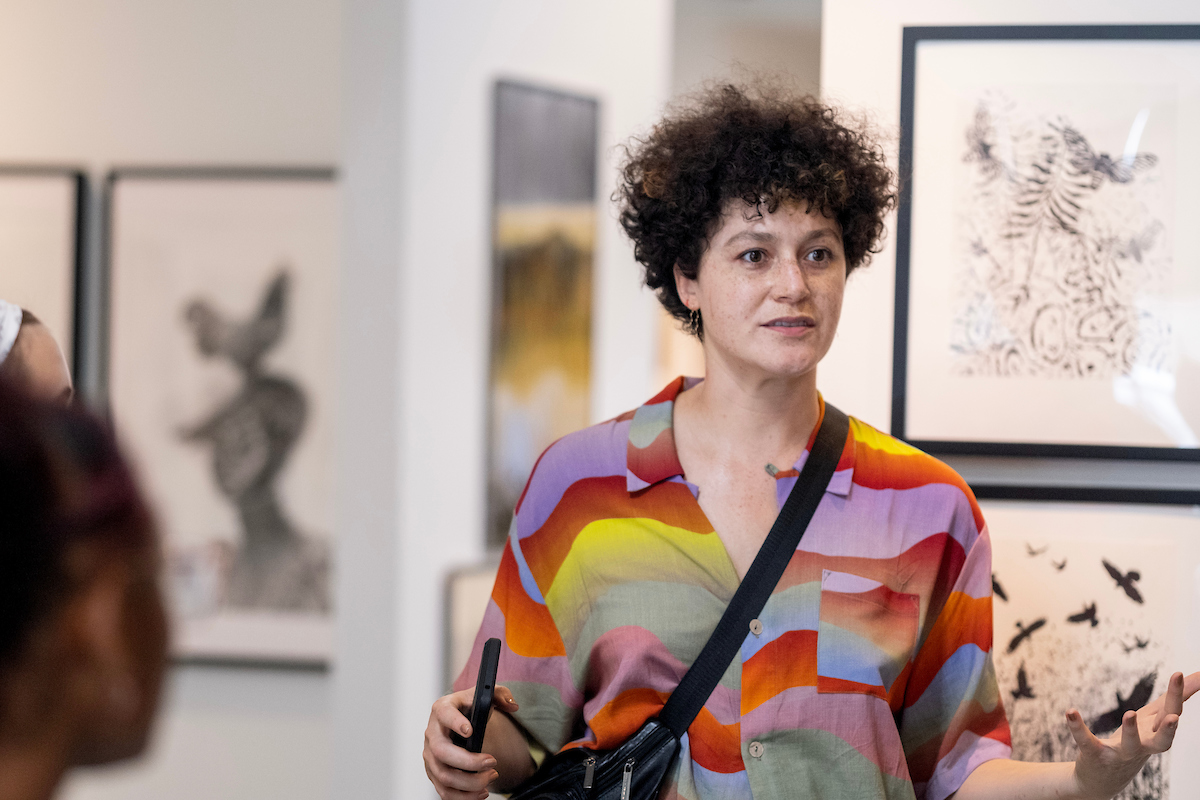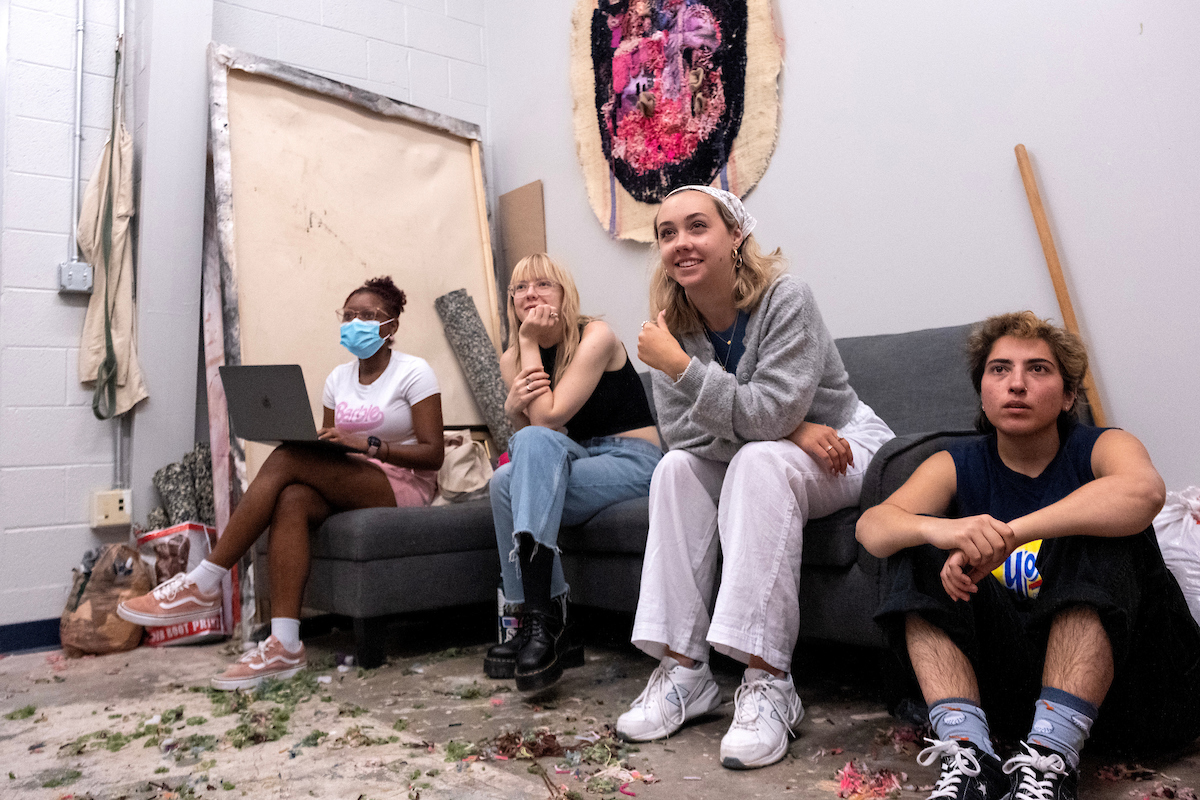Maymester packs rich experiences into 2 weeks
Instructors use smaller classes and an intense schedule to immerse students in field trips, service learning and deep discussions.

On the studio wall hangs an oversized tapestry. It depicts two giant chickens with female faces butchering a hog. Visting student Nina Scott’s take on it? “Girl boss grotesque.”
Scott, her four classmates and their professor, Kathryn Desplanque, are visiting the art studio of Molly English at Carolina’s Art Lab, north of main campus on Airport Road. The trip is stop No. 1 of 18 they are planning to various Triangle venues for Art History 290, “Loving Your Local Art Scene,” this Maymester.
While showcasing her work, English, a Master of Fine Arts student, points out recurring themes of animals and butchery and explains her evolution from a primarily paint-based artist. The students ask about her artistic inspirations, life in an MFA program and English’s creative process.
Next, the students carpool to meet another MFA student, photographer Matthew Troyer, and then to the FRANK Gallery in Carrboro.
“Maymester is the reason I can offer a class like this,” says Desplanque, an assistant professor in the College of Arts and Sciences’ art and art history department. “This class would be extremely difficult to offer during the traditional school year.”
For many Carolina faculty, Maymester means more than cramming a semester’s worth of instruction into two weeks. Thanks to simplified logistics, smaller class sizes and longer, more intensive sessions, instructors can experiment, take deeper dives and practice their craft with a twist.
“I enjoy it,” says Sarah Treul Roberts, the Bowman and Gordon Gray Term Professor in the College’s political science department, who teaches POLI 100, “American Democracy in Changing Times.” “I think it’s really fun to be able to teach the same course but in very different ways.”

Desplanque says the Maymester format makes experiential learning easier and gives students an opportunity to “really consider theory in practice.” (Jon Gardiner/UNC-Chapel Hill)
Exploring art in the Triangle
Desplanque is her department’s 18th- and 19th-century European specialist, so she admits you wouldn’t necessarily expect her to create and teach a class involving contemporary American art. But she has an art practice herself and is active in the local art scene, which she applauds as inclusive and “really welcoming to new people.”
“This class is an opportunity for me to share the communities that I have been a part of the last several years in the Triangle,” Desplanque says.
In this inaugural edition of the course, Desplanque and her students are visiting many Triangle art spots, including the Pop Box Gallery in Durham, Artspace in Raleigh and Attic 506 in Chapel Hill.
In addition to the Triangle trips, students also learn about the sociology of art and changes to the structure of the art world over time.
Those lessons and experiences will inform a collective class project — an interactive local art map that Desplanque plans to launch as a publicly accessible website. For technological help, Desplanque turned to Philip McDaniel, a geographic information system librarian at Carolina. He gave her class access to a powerful mapmaking utility, StoryMap.
Once complete, the map will fill a need Desplanque recognized, allowing community members to learn more about the local art scene and what it has to offer.
“I think that more people would get involved in our local art scene if they had a cheat sheet to help them find where it’s happening, where it’s going on,” she says.
For Scott, the rising Hussman School of Journalism and Media senior who so colorfully characterized English’s tapestry, the mapping combines her interests of web design and art.
“I enjoy making knowledge accessible, and then it connects with my personal desire to create art and maybe one day have my art in a gallery,” Scott says.

Students from the “Loving Your Local Art Scene” Maymester course visit Carolina’s Art Lab. (Jon Gardiner/UNC-Chapel Hill)
Bringing public discourse to life
Treul Roberts often tells her POLI 100 students that “American democracy requires robust public discourse.” When she teaches the course in the fall or spring semesters, she’s usually addressing a room full of 100-plus students, typical for an introductory-level class.
But during Maymester, when her audience drops to the teens, the robust public discourse really happens, Treul Roberts says.
As during a typical semester, the course provides an overview and discussion of topics like the origins of the U.S. government, its political institutions and political behavior. But in May, Treul Roberts and her students engage in lively but cordial discussions — she asks students to sign a code of conduct to “listen charitably to one another” — on everything from the Supreme Court to the meaning of the Constitution to the Electoral College.
With longer class periods and students not balancing their time with other courses, they’re “essentially living, breathing, sleeping American democracy,” she says.
Because Maymester is so brief, Treul Roberts sometimes wonders how many facts will stick with her students. But she believes that’s where the value of the engaging class dialogues and public discord kicks in. Those interactions, she says, they’ll remember.
“I sometimes get people taking Maymester courses [because they] need course credit,” Treul Roberts says. “But they end up enjoying the class, and I do see them in upper-level classes later on.”
Diving into Durham’s development
For those taking Nina Martin’s Geography 429 course, “Urban Political Geography: Durham, N.C.,” theory quickly becomes practice. Students immerse themselves in downtown Durham, studying the development of one of the South’s most rapidly transforming cities.
Early in the course, Martin leads students on a walking tour of downtown and other nearby areas, including the historically Black Hayti neighborhood. They discuss how and why Durham is changing and the associated consequences.
From there, students work with a nonprofit organization, Downtown Durham Inc., serving as consultants and writing a report on migration into Durham from large population centers across the United States and its impact on the local community. The work involves data analysis and online mapping among other skills. The class then presents the report to the organization’s board.
“The depth of the experience is going to be really meaningful for them because they’ll be engaging with this material and thinking about this city, its issues and its potential for three hours a day,” says Martin, an associate professor and director of undergraduate studies in the College’s geography department.
That sort of experiential learning is important for students, Martin says. It’s one thing to read from a textbook or a case study on urban development in large U.S. cities like Los Angeles or Chicago. But doing work themselves in a city like Durham, a place that Martin says doesn’t typically get studied as much because it’s Southern and smaller, can give students an appreciation of how the concepts they learn about play out in real-time.
“I think they like the experience of going and actually just seeing somewhere and getting out of the classroom and being able to connect some of the things we talk about in the classroom — the readings we do — with an actual place,” she says.




